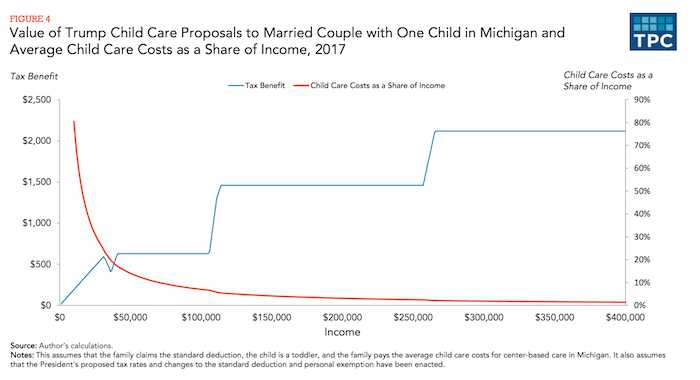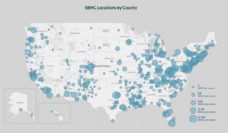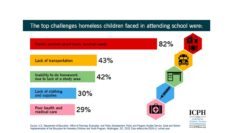During his electoral campaign, President Trump offered a plan for decreasing child-care costs by offering tax breaks to those with child-care expenses. According to his campaign’s fact sheet, the goal of the child-care plan was to “provide the biggest benefit to working-and-middle-class families,” and not the wealthy. His fact sheet noted that these reforms would allow parents greater flexibility in work options.
President Trump’s focus on the affordability of child care is a noble pursuit and one that Republicans have not seriously pursued since the providing support for the Comprehensive Child Development Act of 1971. High child care costs are problematic. The average weekly child care expenses of families have increased by 70% over the past twenty-five years. Child care has become unaffordable and burdensome for low-income families. High-quality, center-based, and affordable child care leads to financial flexibility for families, increases in maternal employment, and better outcomes for children. However noble the aim, Trump’s policy solutions may be misguided and do not offer enough assistance to low-income families.
To be fair, the current tax benefits for child care also do little to assist low-income families. Currently, the Child and Dependent Care Tax Credit (CDCTC) provides tax credits only to parents who work or are in school. Low-income families that are not tax liable do not benefit from the credits because they are non-refundable. More than a third (38%) of the CDCTC benefits are claimed by families that have gross adjusted income of at least $100,000. The second provision of the employer-provided childcare lets parents exclude a maximum of $5,000 from earnings. However, this provision is not offered by all employers. About 80% of the employer benefit goes to families that make at least $100,000 in adjusted gross income.
Trump’s recently released tax plan included one line affirming his commitment to provide tax relief for child care expenses without any additional details on how he would do this. The child care plan Trump proposed during his campaign has three parts:
1. Above-the-line deduction for child care costs for children under the age of 13
Taxpayers can claim a deduction for up to 4 children from their adjusted gross income. Deductions are capped at the average child care costs for the child’s age in the state in which the taxpayer is filing. Unmarried parents with an income over $250,000 or married parents with an income over $500,000 cannot claim the deduction. Stay-at-home parents can also claim this deduction even if there are no formal child care costs.
2. Refundable credit for child care costs for children under the age of 13
Taxpayers would receive the lesser amount of the two options here: 7.65% of child care expenses or 3.825% of lesser-earning spouse’s income. Married parents with an income over $62,400 and families with stay-at-home parents are not eligible.
3. Dependent Case Savings Account (DCSA)
Families are able to contribute up to 2,000 tax-deductible dollars a year per child. All families can participate and there are no limits on income.
The Tax Policy Center (TPC) has analyzed who would benefit from Trump’s child care plan if it were to take effect. The TPC predicts that the plan would disproportionately help high-income families. The child care proposal will cost $115 billion over ten years. Families with an income of at least $100,000 will receive 70% of the benefits, leaving very little for low-income and even middle-income families. The above-the-line tax deduction gives larger deductions to those in higher tax brackets. Many low-income families that are not tax liable would not receive any assistance from the tax deductions.
Low-income families tend to spend less on child care because of their tighter budgets. Often, low-income families rely on more informal arrangements for child care, such as a relative or friend. In this case, families without tax liability could claim the refundable credit. However, the maximum credit under this provision would amount to $459 a year. A couple hundred dollars of credit does not make a great difference in most states when paying for formal childcare. Child care is expensive, ranging from $5,467 in Alabama to $16,430 in Massachusetts for infant care. The first two provisions happen retrospectively and offer no immediate assistance to parents who need to pay the bills and live paycheck to paycheck.
Finally, the DCSA is unhelpful for families that have little expendable income. With less income to contribute to the DCSA, low-income families will most likely not benefit from the tax breaks in this provision.
TPC projected possible the effects of Trump’s plan for families with two working parents with various income levels to truly understand the impact of such a proposal. Keep in mind that the U.S. Department of Health and Human Services pegs affordable childcare to 7% of a families’ income or less. Using Michigan as an example, the average center-based child care costs $8,238 a year. A family with two working parents making a combined income of $30,000 would see a decrease of cost of child care from 27% to 26% of their income under Trump’s plan. A family making $65,000 would see a reduction from 12% to 11%. And finally, for families earning $250,000, they would see a reduction from 2% to 1%.

One way that the TPC suggests to make Trump’s proposal truer to its stated goals is to replace the CDTC and DCSA with an expanded refundable credit. The credit should be given in advance to help families with immediate bills. Previous studies have also suggested limiting the expanded refundable credit to families that make $70,000 or less. Proper reform would provide the much needed support financially for parents and produce better outcomes for children. Unless elements like these are incorporated, the reform would not help the parents with the greatest need.
Feature image: Tom Woodward, own the road, used under CC BY-SA 2.0/cropped from original
Graph from Tax Policy Center, Who Benefits from President Trump’s Child Care Proposals?














